Football Vision 2025
With less than 2-weeks before season 13 of the Hyundai A-League kicks off, there is a calm before the storm. There have been many distractions in the long off-season within our football community, however, I wanted to reflect on the sport and the current landscape.
In my view, all A-League teams have raised the bar in terms of their recruitment for the season ahead. This will only further add to the quality of the A-League in the upcoming season.
I am anticipating a hotly contested Hyundai A-League this season and look forward to Round 1.
As a lead up to season 13, I revisited some key insights into the A-League as they were at the end of season 2016/17:
Key Insights A-League
Much has been said about the progress and development of the A-League, however, in 2016/17, the following was achieved:
- Broadcast numbers improved by 13% on 2016/17 to an average audience of 94,000 per match with Fox Sports up by 11% to an average of 68,000 per match
- Broadcast share also improved with Fox up 6% and SBS2 17%
- All clubs improved Broadcast audience results
- Attendance increased by 3% on 2015/16 to an average attendance per match of 12,641
- In terms of attendances, whilst the A-League is currently the 5th most attended professional sport in Australia, we are not far away from surpassing NRL and Super Rugby which would result in the A-League being the 3rd largest attended sport. This is achievable following the seasons those competitions have just experienced.
- Globally, the A-League is the 14th most attended football league in the world, which really provides some perspective
- Memberships are up 9% and are at the highest number on record at 117,415 with this tend expected to continue for 2017/18.
- Since 2009/10, club membership numbers have doubled
Perth Glory Football Club
At Perth Glory, we are on-target to reach another Club membership record of 10,000 members on the back of achieving average attendances of 10,533 during the 2016/17
https://peterfilopoulos.com/reflection-first-12-months-perth-glory-way/
People constantly compare the Perth Glory A-League era with the National Soccer League era which prompted me to recently conduct some research on facts, thanks to statistician, Andrew Howe
During the NSL era between 1996/97 - 2003/04, the club averaged crowds of 12,403 compared to the current 10,533. However, in the last two (2) years of the NSL, both Championship years, the club averaged 9,873.
Notwithstanding these numbers, they were the highest attendances of the old National Soccer League at the time. A couple of points to raise on this:
- There was no live television against the gate in the NSL era and nor was English Premier League as accessible on television as it is today.
- Perth Oval was really the only avenue a football fan had to consume football in Perth and WA other than local football
- Today's technological capabilities are more accurate in providing attendance figures
The club membership today is at the highest it has ever been in the 21 years existence of the club.
Whilst not denying the spectacular emergence of Perth Glory in 1996, I find this data every interesting and provides perspective in terms of where the club is today and where it is heading.
What has eluded the club in its A-League era has been silverware which it craves. We are working hard behind the scenes to achieve in both the A-League and W-League under the new strategic plan, The Perth Glory Way.
The current landscape
Whilst I won't make any comment around the current political landscape of our great game in my position as CEO of Perth Glory Football Club, I am looking forward to the day we can align all stakeholders and develop a collective vision for how we want the game to look like in the medium to longer term.
When I read and listen to all the commentary surrounding the football issues, I see a lot of ambition. Ambition is great and some of the best outcomes in life are derived by ambition and strong vision.
No one can deny the progress of the sport in terms of its participation numbers and the development of the A-League. The emergence of the FFA Cup has uncovered some gems as well as a strong and vibrant community.
This has seen the rise of clubs in the grassroots and lower leagues (largely forgotten by 'new football") which has given them a taste and reinvigorated their ambition in what they perceive is their future roles in Australian football.
To me crisis brings opportunity to unite the community behind one vision.
Ambition vs Capability
In a discussion recently with someone I consider a mentor, we spoke to about the concept of matching ambition with capability.
I have pondered this concept in relation to football and the current challenges we confront. The key factors to take into consideration when you attempt to match ambition with capability are as follows:
- Matching ambition with capability is critical
- Trying to build capability quickly can be costly
- Vision without action is just that, a dream
- Action without vision, is a nightmare
All these points ring true, however, the big point for me is:
- Congruence. Without congruence, we can not achieve our ambition irrespective of capability.
The key word which best describes our current landscape is incongruence.
Finding harmony in the sport and uniting behind one vision is at its most crucial stage. Capability can be built over time by implementing a prioritised phased process. Our biggest obstacle is congruence.
I often imagine what can be achieved if we were in a congruent, one sport, one vision environment. Having said that, there is a lot of impatience and the importance of matching the ambition with capability is also crucial.
Where we have come from
With the demise of the NSL in 2004, football took a direction to corporatise the sport, something that had to happen.
Much was achieved in re-landscaping and energising the national competition through the new and glossy Hyundai A-League. Much needed corporate revenue made it possible through a television rights deal with Fox Sports and a naming rights deal with Hyundai.
In doing so, we left some key ingredients behind and failed to take a large proportion of the football community at the time along on the new journey creating the divide of "old soccer" and "new football", something that has never sat right with me.
Being a Melburnian most of my life and following the game since 1977, I personally saw the huge void that was created at the time with thousands of football fans not taking to the A-League as they felt a sense of non-belonging. This still exists today after 13 years.
Football Community
In my view, it is time to truly connect the entire football community.
Not all was bad under the National Soccer League as some may tell you.
The National Soccer League clubs were largely responsible for the "golden generation" of developing high achieving Socceroos and Young Socceroos that not only played in the NSL, but went on to play for some big clubs throughout the United Kingdom and Europe.
Where the NSL failed was corporatising the sport, something the A-League has succeeded with.
Now is the time to connect the football community and collectively develop the vision that will continue to ensure the great game of football prospers in this country. What that looks like? It depends on how we collaborate to articulate the vision and build on the ambition.
By doing so, we will unlock some great capability, empower people and organisations and harmoniously execute a carefully devised plan to continue the path for football as the most participated sport and making it the second highest attended professional league in Australia.
Looking Ahead
By embracing the past and uniting it with the present, we can create a powerful landscape for all stakeholders to prosper in the future. Now is the time to develop Football Vision 2025, the strategic plan that unites the entire football community as one sport.
There is so much ambition to harness and bring everyone along an exciting journey ahead.
For now, I look forward to the FFA Cup Semi-Finals and Grand Final and the commencement of an exciting Hyundai A-League season 2017/18 as I continue to ponder what we can achieve working together as a congruent family.
In closing, I would like to reiterate, these are my personal observations which I share openly and which I enjoy discussing with our growing and wonderful football community.
Some don't appreciate my opinions or views, however, I feel its important that we continue to strive for better and having the dialogue can only help the development of football.
Interested in your thoughts.
Yours in football
Peter Filopoulos
Perth Glory Football Club, the journey so far ahead of the Hyundai A-League Semi Final
Mike Cockerill Opinion Piece in the Sydney Morning Herald, Saturday 29 April, 2017
Mike Cockerill from the Sydney Morning Herald, takes a look at the resurgence of the Perth Glory Football Club ahead of the Club's Hyundai A-League Semi Final vs Sydney FC on Saturday 29 April, 2017.
The journey so far has been revealing but the road ahead under the four year strategic plan, "The Perth Glory Way" is even more exciting.
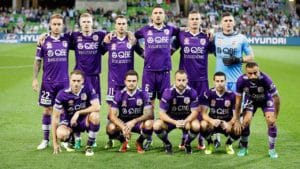
29/04/2017
CEO Message to Perth Glory members - April 2017
The last time I penned a message to you was in our 2016/17 Membership brochure when we officially launched our Membership campaign in June, urging you all to sign up for another season of Glory.
Since then, it’s been a busy season at headquarters and I am pleased to report that in that time we have achieved some significant milestones as a club.
OUR ACHIEVEMENTS TO DATE
Celebrating our history
- We celebrated our 20th season of national competition combining both NSL and A-League eras. It was great to see so many old faces throughout the year, especially at our Round 1 match against Central Coast Mariners when we honoured the inaugural team, coaching staff and founding owners of the Club. During the season we have also had visits from ex coaches, Bernd Stange and Mitch d'Avray. As part of the 20th season celebrations, we now look forward to unveiling the Perth Glory Ultimate XI (1996-2016) at the Most Glorious Player Awards night on Saturday 13 May at the Perth Convention and Exhibition Centre and hope you can join us on this magnificent occasion.
Our growing membership
- For the third consecutive season, we have broken our membership record ending the year with a high of 8,644 members (a 21% increase on the previous year), noting our target was to sign 8,500. We have now shifted our focus to the 2017/18 campaign where we are striving to break another record by achieving 10,000 members as forecast in our four-year strategic plan released in early 2016.
- I would like to thank you for your continued and unwavering support and hope that you will be there with us again in season 2017/18 as we strive for even greater heights. As I have said before, only together can we build success and become even stronger. As a member, you are the lifeblood of our football club and we highly value your continued support.
Our growing attendances
- Our attendances have also grown this season with a crowd average of 10,533, up from 8,986 last season (a 17% increase) and an A-League record for the club. This places us well on track to achieve our strategic target of 12,500 by 2018. We encourage you to spread the word amongst your family and friends and bring them along to Perth Glory matches next season to share the match day experience.
Our A-League and W-League feats
- Our A-League team has once again qualified for finals by securing fifth spot. While we had loftier aspirations at the beginning of the season, it’s pleasing that we have been able to earn a finals spot in consecutive seasons as we face Melbourne City this Sunday at AAMI Park for a spot into the semi-finals.
- Our Women’s team made us proud by qualifying for a home W-League Grand Final against Melbourne City which was a magnificent achievement and provides us with a great platform to make an assault for our first W-League title next season.
New training and administration headquarters
- The club has moved into a new training and administration headquarters, sharing facilities with Western Force and Rugby WA and also looking to expanding our player amenities at the premises. Simultaneously, we are working closely with Football West in developing a business case and lobbying Government for a new State Football Centre for Western Australia’s largest participating team sport.
Chelsea is coming to Perth
- We announced during the year that we will be playing English Premier League giants, Chelsea Football Club at the new Perth Stadium in July / August, 2018. This is another reason to renew your Membership for 2017/18 as you will receive access to a pre-sale opportunity allowing you the first rights to the very best seats in the house on this historic and magnificent occasion.
Our membership satisfaction
- In an independent research report commissioned by FFA and conducted by The Gemba Group, Perth Glory Football Club ranked first for overall membership satisfaction in the A-League. Our members were the most satisfied with the benefits and value of their membership packages, the membership and renewal process as well as the game day experience on offer at nib Stadium. Pleasingly, we were also seen as having the most satisfied members in the A-League with our marketing and communication to members, sense of club involvement and club administration.
WHAT WE ARE STRIVING FOR FROM HERE
Easter Sunday marked the end of the regular 2016/17 Hyundai A-League home and away season and what a spectacular match it was for our last home game with nine (9) goals scored in an end to end, non-stop drama right up until the final whistle in front of 12,261 members and fans.
While we are pleased with the progress we are making as a Club, the work has only just begun and we will not rest on our laurels, already turning our sights to planning for season 2017/18. It will be a busy off-season as we prepare for season 13 of the Hyundai A-League.
As we strive to win our maiden Hyundai A-League trophy this finals campaign in addition to the two (2) National Soccer League trophies, we will continue to aim for a spot in the AFC Champions League. With your continued support, we are determined to once again break our membership record and surpass 10,000 members and head towards average crowds of 12,500.
Our NPL teams are in full swing at the moment and we encourage you to support our teams where possible.
As mentioned our Most Glorious Player (MGP) Awards will be held on Saturday 13 May, 2017 at the Perth Convention and Exhibition Centre. We look forward to seeing you on this prestigious evening.
Right here, right now
Today, our full attention turns to AAMI Park in Melbourne, where we face Melbourne City in a crucial Elimination Final. I am sure you will join me in wishing our team all the very best for this match. A win today will secure a spot into a Semi-Final match to play off for a Grand Final berth. Those who will be at AAMI Park for the match, make your presence felt and to those watching in pubs and homes throughout Perth, support with gusto.
We want you back on board in 2017/18
In closing, I would like to once again sincerely thank you for your membership of our football club. Our 2017/18 Membership campaign kicks off soon and with your continued support we are confident of an even bigger and better 2017/18 Hyundai A-League season.
THANK YOU!
There is only ONE Perth Glory. #GLORYISOURS
Warm regards
Peter Filopoulos
Chief Executive Officer
Proud and Paid Up Member No. 19239
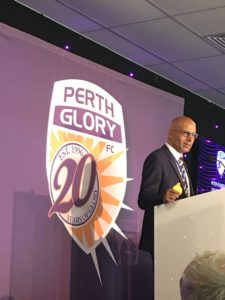
Procrastination – when do you pull the trigger?
I stumbled across this quote which applies to so many different aspects of life and business:
Habitual procrastinators will readily testify to all the lost opportunities, missed deadlines, failed relationships and even monetary losses incurred just because of one nasty habit of putting things off until it is often too late.
Stephen Richards, The Secret of Getting Started: Strategies to Triumph over Procrastination
Bound for Glory – as featured in the CEO Magazine, October 2016
CEO Magazine Feature October 2016 | Bound for Glory
The CEO Magazine wrote a feature on the Perth Glory Football Club for their October 2016 edition and can be found on the link above. The feature highlights the journey we have embarked on since I took on the CEO role at Perth Glory FC in August 2015 and the road we are embarking on ahead.
The Digital Disruption and Sport
Recently I was asked to speak at the Business of Sport Summit BOSSummit in Sydney where I participated on a panel of speakers on the topic of:
Changed Game: Predicting and Preparing for the Future in Sport
As sport changes both on and off the field, innovation has become a key priority for all industry stakeholders. What can we predict about the future direction of sport in the region? How can sports executives adapt the dynamic energy of sport to build new audiences and create new business models? Which sports can we expect to experience growth in the next decade, and which will experience decline?
When I first received this topic at hand, I found it rather thought-provoking. All sports have evolved over the last 100-150 years and to dabble at the thought of how sport can look like in the future is confronting.
To me the first topic that sprung to mind was the digital disruption we are currently experiencing and how sports and entertainment has or has not adapted. To add to this is the in-home experience fans are now able to experience vs the in-stadium experience which goes hand in hand with the extraordinary television rights deals many sports are now achieving.
The in-home experience of consuming sport is getting better and better and changing in lightning speed with home theatre systems that provide HDTV and surround sound, smartphone streaming and video-on-demand, the fans of today have plenty to choose from so we know it can be hard to get them out of their lounge rooms and into the stadium / arena for a live experience. With the rapid pace that technology is developing, this challenge undoubtedly presents an increasing issue.
 The TVs are getting bigger, high-definition viewing with sound bars and all the specialty commentary and stats one could ever desire creating an amazing experience, all in the proximity of one’s own fridge with cheap food and beer.
The TVs are getting bigger, high-definition viewing with sound bars and all the specialty commentary and stats one could ever desire creating an amazing experience, all in the proximity of one’s own fridge with cheap food and beer.
In contrast, what was the in-stadium experience like? Everyone talks about fan engagement, the buzz words in sports and entertainment at the moment, but what does all this mean and who is doing it well?
I was confronted with the challenge of the in-stadium experience only in the recent two years in my role as Director of Sales, Marketing and Communications of a world-class stadium, Etihad Stadium where I was the project lead for the connected stadium strategy to help improve the fan experience at the stadium and also provide an environment where we provide a customised experience for the variety of fans and clubs that made the stadium home (5 x AFL Clubs, 1 x A-League Club and 1 x Big Bash League Club).
The challenge was, how can we present the stadium like a true home ground for the specific tenant club fans at their home games and how could we provide the 1.7 million fans that visit the stadium each year the ultimate live experience. The other challenge was, how do we find the millions required to transform the live experience in-stadium.
We have all experienced packed stadiums and arenas where you are unable to make a phone call or browse the internet, Facebook or other social sites due to congestion. In today’s world of technology which we rely upon heavily, this is a frustrating experience.
When we embarked on this project, we looked widely within Australia of examples of best practice. Our search didn’t take long at all as it became quickly apparent that despite it being 2013, many stadiums, venues and sports across Australia had not been active in this space of innovation and connected stadiums which in turn could create better fan engagement environments.

At the end of 2013, it was timely that Telstra commissioned several venues to their boardroom in Sydney in an attempt to collaborate on the idea of connected stadiums in a round table discussion. In the room, I found a number of executives such as myself who were challenged at the thought? What does all this mean? Credit to Telstra and Kathy-Ann McManus for inspiring this very open and fluid meeting and the discussion that followed demonstrated to me the lack of expertise and knowledge in the room. The only venue at that time that had embarked on installing a high-definition Wi Fi network was ANZ Stadium.
I recall Daryl Kerry, the CEO of ANZ Stadium telling the room that they had embarked on the journey and whilst they weren’t fully understanding what this all meant, they were looking forward to learning about it as they went through the process. I looked at Daryl at the time as a leader and innovator. He was prepared to plunge into the world of a connected stadium and invest a considerable amount of financial resources but understood that as much as you prepare for a new and brave world, “the risk of inaction is far greater than the risk of action”.
This term is very fond to me as I first heard it in a meeting with the CEO of IBM at the time, Andrew Stevens, when they were responding to our request for proposal for the installation of the high density Wi Fi and iPTV network at Etihad Stadium several months later. I recall vividly in a meeting him saying,
“Gentlemen, you can write all the papers you want on a connected stadium project, but at the end of the day, the risk of inaction is far greater than the risk of action”. He proceeded to say “the longer you take to come to grips with the new world of innovation and technology and all that comes with it, it becomes a compounding effect and the further you fall behind. The stadium experience in Australia is quickly becoming archaic and we need to move quickly in the world of connectivity. Your customers demand it now and will increasingly demand it in the future”. Andrew Stevens, IBM Australia – April 2014
This round table discussion at Telstra prompted us at Etihad Stadium to embark on a fact-finding mission globally. What were stadiums doing overseas when it came to the new connected world and how did they create a better environment for their tenants and rights holders. This lead our appointed consultant for the project, Paul Yeomans and myself to the USA where we visited stadiums and arenas in Kansas City, Miami, New York and Los Angeles.
The Americans were well advanced in this space and we took a lot of inspiration, particularly from the Barclays Center in Brooklyn, home to the Brooklyn Nets. We attended the second NBA play-off between Brooklyn Nets and Miami Heat who we had incidentally also seen play in the first playoff in Miami.
Another stadium which presented me with a great experience was in Kansas City of all places at Sporting Park the home of MLS franchise Sporting KC. A bespoke stadium accommodating 21,000 people was purpose-built to provide a first class live football experience. Sporting KC This is what the CEO of Sporting KC, Robert Heinemann, had to say about the live experience they created at Sporting Park.
“Building on our technology strategy which centers around enhancing the fan experience, Sporting Kansas City chose Experience based on their innovation and sole focus on the fan. Experience’s mobile technology, integrated into our Uphoria app, will be fast for fans to use as well as very simple and intuitive. Sporting KC fans will be further empowered to personalize their game day experience, whether it’s having the ability to purchase an on-field experience or simply enabling a seat move to get closer to the action, our fans will be able to use technology to create a memory and make the most of their visit to Sporting Park.”
The high density Wi Fi we experienced at both the Barclays Centre and Sporting Park was more powerful than the normal residential Wi Fi, the LED displays lit up the stadium, the thousands of iPTV screens around the arena were influencing everything you wanted to do at the stadium from merchandise offers to food and beverage bundle deals to where you could purchase tickets to the next game or concert being held at the venue intertwined with strong Brooklyn Nets and Sporting KC branding. You could even upgrade your seat once you were seated and desired to sit somewhere else.
Having logged into the Wi Fi at Barclays Center, I was receiving beacon-triggered messages with merchandise and food & beverage offers nearby and helping me get directions there. One condition of logging into the Wi Fi network was that I download the Barclays Center iPhone app and volunteer my information, email and mobile phone number. Such a powerful data play.
The app provided instant relays, live action, statistics, sponsor offers, ticketing promotions and so much more. Combine this with the non-stop audio and visual experience, I walked away from that evening inspired and comparing it to the stadium experience back home where by in large you couldn’t get connectivity and on many occasions couldn’t even make a phone call due to the congestion. At the time, LED signage and high density stadium Wi Fi was still by in large immature in Australia.
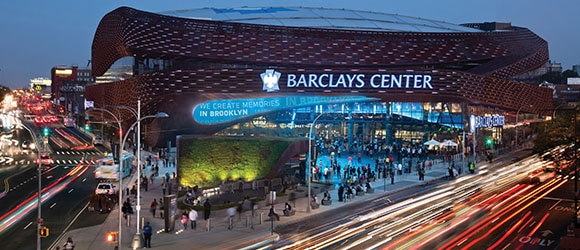
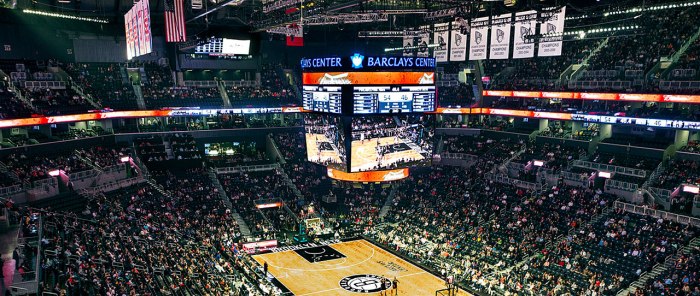
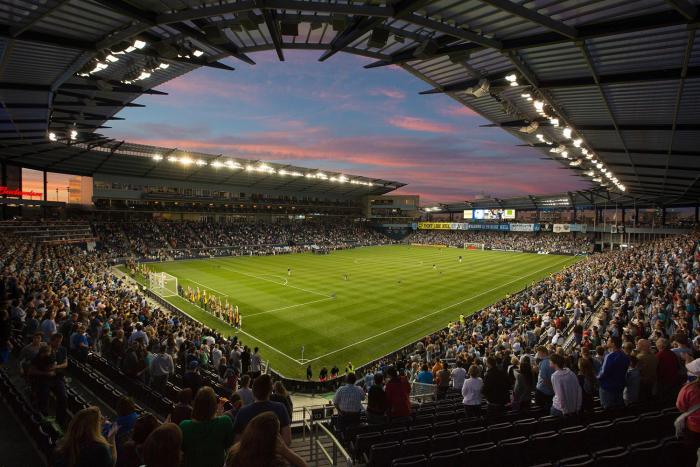
In a short space of time, and with some help from many people along the way, we were able to develop a connected stadium strategy for Etihad Stadium which would bring to the stadium a high density Wi Fi infrastructure, 1,600 iPTV screens and LED in-bowl signage for the perimeter fence and level 1 parapet. The project was developed with a financial model which was fully funded by partnering on the advertising rights with a media agency for five (5) years.
The key to our success in developing and implementing our connected stadium strategy was the desire to innovate and be market leaders.
Etihad Stadium announced in mid 2014 its decision to partner with Telstra, Cisco (infrastructure), PMY (Project Manager) and OAMM (Media Agency partner) to create a connected environment that provides fan engagement and a match-day experience that is unrivalled in Australia. Within a space of 12 months we were able to develop our strategy with certainty and decisiveness.
Fans first experienced the full implementation in March 2015 following the venue’s multi-million dollar investment which at the time made the stadium the most connected and technologically advanced in Australia.
From Round 1 of the 2015 AFL Premiership season, fans at Etihad Stadium were presented with exciting content displayed on the more than 1,600 IPTV High Definition screens and an enhanced connected live experience through the 704 high density WiFi access points that had been installed to provide attendees with fast and free internet connections when they are at the ground.
Fans could once again feel at home with the venue coming to life with its club colours through the 1,600 iPTV screens scattered around the stadium, LED ribbon displays in-bowl and access to all the content they would desire through the high density WiFi system.
Never again would a fan attend an event at Etihad Stadium and not be able to make a phone call due to congestion or struggle with connectivity to browse the internet and use their apps at will. The media as they saw it at the time includes this article from The Age.
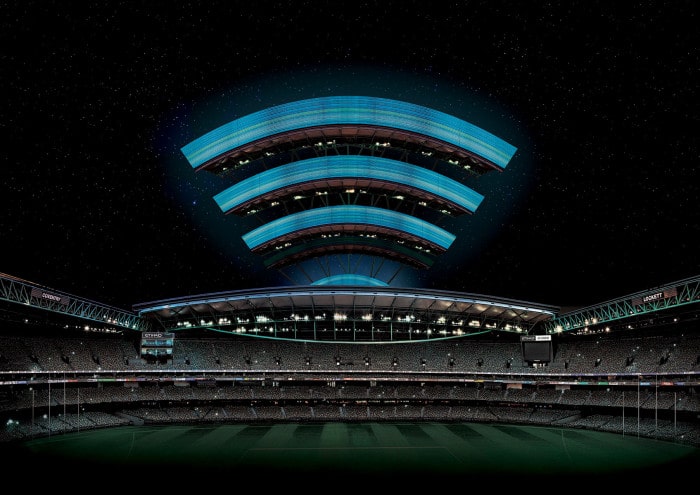 Confronting new technology and taking on the challenge was one of the most rewarding projects I have had to ever work on. During the time, it was helpful to collaborate and seek the advice of a number of people and companies. However, evolving the live experience at stadiums and arenas remains a challenge and rights holders and venues need to continue to grapple with the rapid pace of technology and a new generation of fans and how they want to consume sports and entertainment.
Confronting new technology and taking on the challenge was one of the most rewarding projects I have had to ever work on. During the time, it was helpful to collaborate and seek the advice of a number of people and companies. However, evolving the live experience at stadiums and arenas remains a challenge and rights holders and venues need to continue to grapple with the rapid pace of technology and a new generation of fans and how they want to consume sports and entertainment.
I recall spending countless hours with Manny Spanoudakis from Cisco, who has now become a very close friend since meeting as a result of this project, along with other industry experts sharing their experiences of the implementation of connected stadium strategies around the world. This project wouldn’t have been possible without collaboration and inspiration.
In the end, actions spoke louder than words as we embarked on this exciting journey of discovery and dared to look into the future.
Sports broadcasting is also going to become an interesting sphere over the coming months and years. Major sports derive valuable revenue from sports broadcasting and with the various forms with which fans now consume sport, we will see a mix of rights via the traditional free to air television networks, subscription television and now the fast emerging over the top avenues provided by providers such as Netflix and Fetch. English Premier League Australian rights for the 2016/17 season will shift from subscription television (Foxtel) to over the top (Optus / Netflix).
Furthermore, the broadcasters are beginning to demand more from the rights holders in terms of how the sport is presented and made more entertaining for the home viewer. The Big Bash League on Network Ten is a prime example of this. All of this leads to increased competition to the live experience and it all points towards rights holders and venues having to work even harder to deliver a better live experience than the in-home or from your own device experience.
Peter Filopoulos
My accidental career path in sports
Over the years, I am regularly asked by bright eyed young people, how did you get into sports administration? A career in sports has become a major career option progressively over the last fifteen years or so, but this career path wasn’t so prevalent when I graduated from university in 1991.
My first job in sports came in December 1993 in a totally unplanned and unexpected manner. Prior to this and as a Bachelor of Business graduate with a major in Accountancy, in 1991, I embarked on my career in this field, firstly with a construction company and then a marketing / licensing business.
Around the same time, a close friend, Peter Abraam, invited me to join a sub-committee at the National Soccer League Club, South Melbourne Soccer Club. Peter was a former player and now on the Board of Directors of this historic club and at the time, working as a Project Manager with the City of Melbourne. South Melbourne Soccer Club was making a conscious effort to attract a younger profile onto their Board, which was at the time predominantly made up of first generation Greek businessmen. Around this time the famous Hungarian, world renown ex Real Madrid player and coach Ferenc Puskas was coaching the Club and had coached the Club to its first national Championship in 1991 since 1984 with Ange Postecoglou as captain.
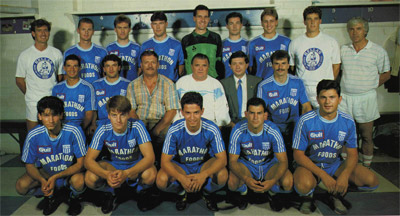
My initial involvement was as a Social Club sub-committee member where our charter was to raise much needed revenue and funds to support the Club’s quest in the National Soccer League. Over the course of 1991 and 1992, we managed to initiate a number of successful activities and initiatives resulting in a secondment onto the Board of Directors in 1992. I recall the Annual Presentation Night Balls we used to hold where I worked with fellow Directors such as Peter Abraam (ex head of the Victorian Major Events Corporation), Emmanuel Kotis, Jim Karakoussis, John Dimitropoulos and Peter Cartsidimas. They were amazing nights well renowned within the South Melbourne Soccer Club and Greek communities of Melbourne held in the most prestigious functions rooms around Melbourne.
As a Board Member, I was able to bring to the table some strong administration skills and fresh new ideas and one of my first initiatives was to request a computer for the Club. I still recall the looks on people’s faces when I made this request, explaining that I wanted to digitalise a lot of our processes. Peter Abraam was delighted at the time as he had been asking the same for some time. The main reason I had requested a computer is that I wanted to migrate the Club’s Membership database from a manual database to a computerised database. Direct Mail under the old manual system was simply a nightmare. Quite quickly, once we acquired the computer, we managed to migrate the entire database onto a D-Base system at the time and we embarked on a data acquisition campaign so that we could begin a more aggressive membership program. Marketing material would be generated from the computer and Direct Mail became more prevalent. On the back of these campaigns, we had immediate impact. Each week at the Board meeting, I would present hundreds of new membership applications with enclosed cheques and our Treasurer at the time was one happy gentleman. It’s hard to imagine that the Club functioned with only a committee of management in place at the time who met for hours each Thursday evening which often went well into the morning hours. Thankfully we had a great social club where we would gather to have dinner after we had watched the first team training and before the meetings would commence at 7:30pm. The mixed grills prepared by Jimmy and Filio were something to look forward to. Having met and befriended Cameron Schwab, then CEO of Richmond AFL team, their management team wasn’t very big at all either at the time in comparison. Full time administrative set-ups and careers in sports administration in 1993 were not very prevalent.
After months of this activity and other influences the younger generation had on the Club via seats on the Board, the Board turned their focus to the possible requirement for a full-time General Manager, given that they could see the great outcomes generated from some organised activity. The Club already had what they titled a ‘Marketing Manager’ in a gentleman I remain very good friends with today, Barry Horsfall. The fact is, Barry was a self-funded employee as he was only earning a commission on new sponsorship and adverting deals he would generate. He did a great job in selling signage packages at the old home ground at Middle Park , which was demolished in 1994 to make way for the Australian Grand Prix track. He would bring a cheque in for $X and he would immediately be remunerated with his pre-agreed commission of 30%, a formula that worked for some time. This was a win-win and successful arrangement.
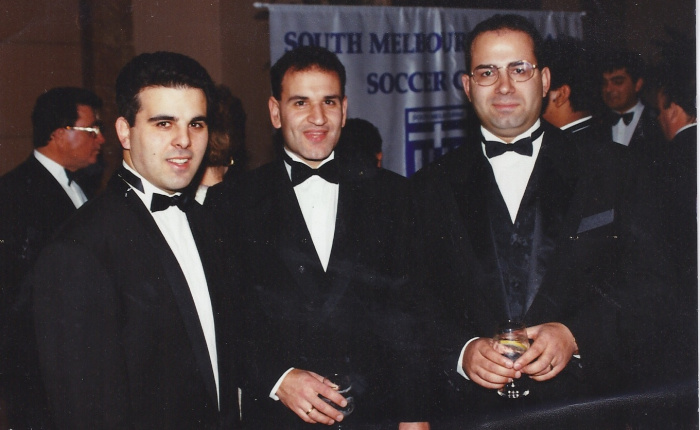
The discussion of a full-time General Manager occurred whilst I was on vacation and on my return I received a phone call from fellow Director, John Dimitropoulos, then an associate solicitor with a former President’s and Chairman and co-founder of the NSL, The Late Sam Papasavas OAM, to advise that the Board was now actively looking for a full-time General Manager and that several people had nominated me as the ideal candidate. The conversation went as follows:
“Pete, while you were away, we spoke at the Board Meeting about the need to appoint a full-time General Manager at the Club to oversee the day to day activities of the Club, some of us thought that you may be the ideal candidate. If you are interested, this would require you to step off the board and become our inaugural General Manager. This could change your life for ever.”
At the time, I was returning from vacation to accept a job with a national architectural firm as their State Accountant, a great job with an attractive package and consistent with my qualifications. This and subsequent conversations with John, the President, George Vasilopoulos and fellow Director, Peter Abraam, threw a spanner in the works. In speaking to my family, they thought it was a crazy idea. I recall clearly my father asking me if I had lost my mind at the prospect of deviating from my chosen vocation to take up a post with the Club.
A career in sports in 1993, was not a well known or accepted career path, not the way it is today. So much so, the most asked questions at barbecues was, “so what do you do in the off-season?”
Against all advice, my instincts told me otherwise and at the age of 25, I accepted to become the inaugural General Manager of the South Melbourne Soccer Club in December 1993 and commenced immediately. I clearly recall waking up on the first day of my new job bouncing out of bed with a spring something I still do over 22 years later. At such a young age, I had so much to learn and was wide-eyed and full of energy as General Manager of the biggest and most successful football club in Australia.
What I didn’t know at the time was that I had embarked on a career in sports something I look back on today. This was the platform from which created my opportunities from thereon. John Dimitropoulos was right, this decision was about to change my life forever in a way I couldn’t possibly imagine.
The beginnings
From my appointment as General Manager of South Melbourne Soccer Club, it was a baptism of fire. So much to learn, however, it was great to have such good mentors and people that supported me. Peter Abraam in particular, would be on the phone multiple times during the day, steering, mentoring and inspiring me. He still inspires me to this day. We all became such close friends and every one at that time had an influence to my induction into the new role. Many of these friendships remain in place even today, with both players and board members.
Our offices were underneath a grandstand at the stadium which accommodated a board room and a small office where I think I banged my head on the ceiling on several occasions. It was in this office that one day in 1994 I received a phone call from the Head of Sport at Melbourne Grammar School who were searching for a Head Football Coach. I recommended that they speak to our recently retired star player in Ange Postecoglou who was by this time Assistant Coach with the Club. Ange took on the role and I remember him coming back and telling me it was fantastic and that the school was paying him more for a part-time role than what the club was to be Assistant Coach. Ange delivered that message in a way only Ange can and we often joked about it.
The Australian Grand Prix arrives….
My initiation into the new role went into a spin. Within weeks of commencing, we had received a phone call from the Premier’s office to arrange a meeting with the Club. Upon attending the meeting, we were advised in absolute confidence that Victoria had almost acquired the Australian Grand Prix from Adelaide and that the race track would be in Albert Park Lake. We then learned that as part of this grand plan, the pit straight was going to run right through our then home ground, Middle Park Stadium, home to the Club since 1960 and which we had just signed a 21 year lease for and had plans to re-develop with a new grand stand. Our world had momentarily turned upside down.
Negotiations commenced immediately for appropriate compensation which resulted in the Club receiving a 21 year lease on Lakeside Oval (now known as Lakeside Stadium), once home to South Melbourne Football Club who was years earlier relocated to Sydney as the Sydney Swans. The lease also incorporated a two-storey dwelling which housed a function centre upstairs and a social club and office space downstairs. It was perfect!
With significant additional funding also provided by the government as part of the relocation package, we raised another $3.5M to build the purpose built football ground and after selling the naming rights, soon to be known as Bob Jane Stadium, which opened in December 2005. It was a facility admired by all in football and this legacy remains today.
This process took a lot of hard and dedicated work and we were fortunate to have so many good people on our Board, lawyers such as Peter Mitrakas and John Dimitropoulos, Architects and Project Managers such as Peter Abraam, strong accountants such as Jim Karakoussis, a PR specialist in Jim Stiliadis and a politically savvy President in George Vasilopoulos at the time who forged a close relationship with the Premier Jeff Kennett, someone who also became our number one ticket holder in 1994.
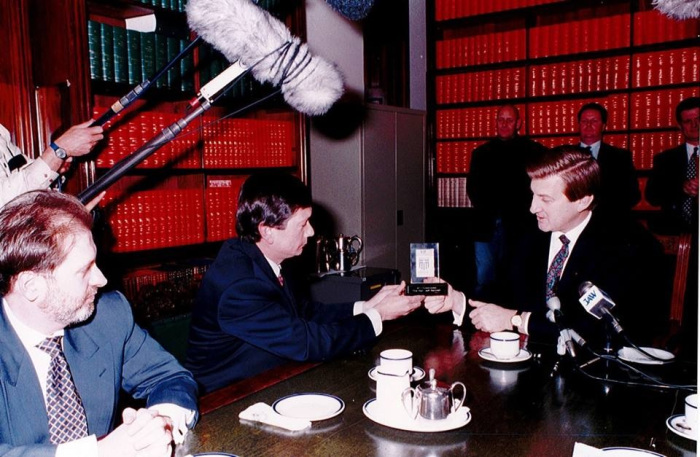
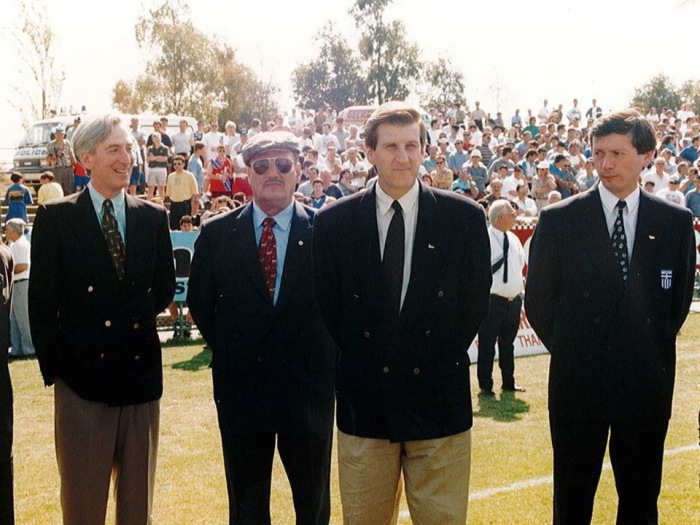
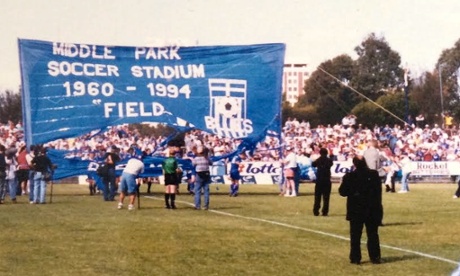
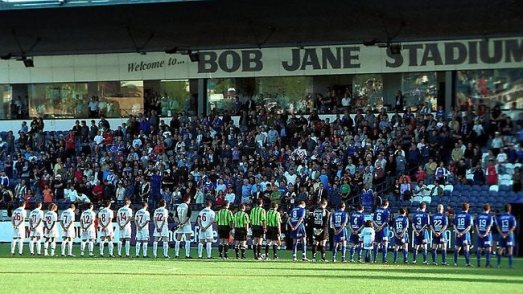
The Frank Arok era
The Club has entered a new era. In July 1994, we had appointed the longest ever serving Socceroos Coach, Frank Arok as our coach after lacklustre 1992/93 (after finishing first) and 1993/94 (after finishing second) NSL seasons where we would reach the finals and bomb out at the Preliminary Final. There was a lot of fanfare about Frank’s arrival to South Melbourne having been a leading coach in Australian Football for decades.
Frank was crucial in the identification and recruitment of a raft of upcoming young talent which formed a nucleus for the successes we enjoyed long after Frank’s tenure. Names like Billy Damianos, Tansel Baser, Steve Panopoulos, Con Anthopoulos, Con Blatsis to name a few. Frank brought in a renewed belief in our junior development and plucked these players from our juniors to add to the big names like Paul Trimboli, Con Boutsianis, Ange Goutzioulis, Socceroo captain, Paul Wade, Mike Petersen, Steve Tasios, Francis Awaritife, Mehmet Durakovic to name a few….
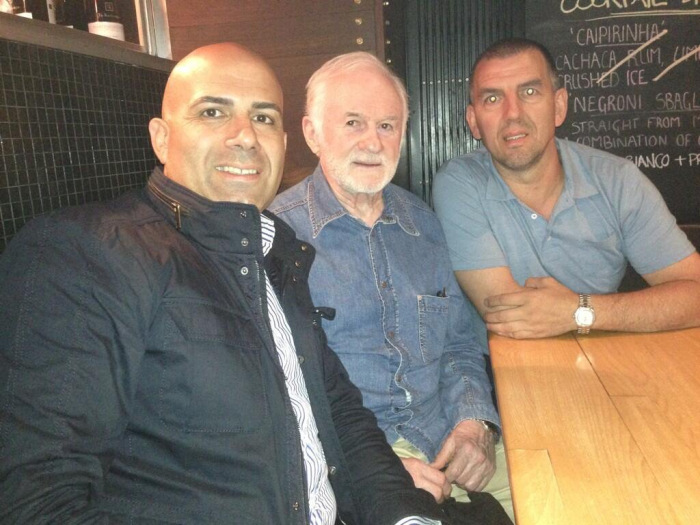
For 1994/95 season, under new coach Frank Arok and his recently retired South player, assistant coach – Ange Postecoglou, we played out of the old Olympic Park in Melbourne, as our new stadium at Lakeside Oval was being constructed, where we again bombed out at the Preliminary Final against Melbourne Knights with a memorable 3-goal performance by the V-Bomber, Mark Viduka. I still remember the hurt on everyone’s faces after this game and there was even a little scuffle in the dressing rooms involving a couple of players that day which reinforced how much we were all hurting. We had drawn the line in the sand – we wanted and demanded success. This came several years later under a new coach, a young Ange Postecoglou, who picked up the baton from Frank and continued the journey in his own style. Ange was magnificent in instilling a sense of ambition and desire for success.
There were fond memories for the South Melbourne faithful of Olympic Park where we had won our latest Championship during the 1990/91 season in spectacular fashion against cross-town rivals Melbourne Knights in the most amazing penalty shoot-out one could ever imagine.
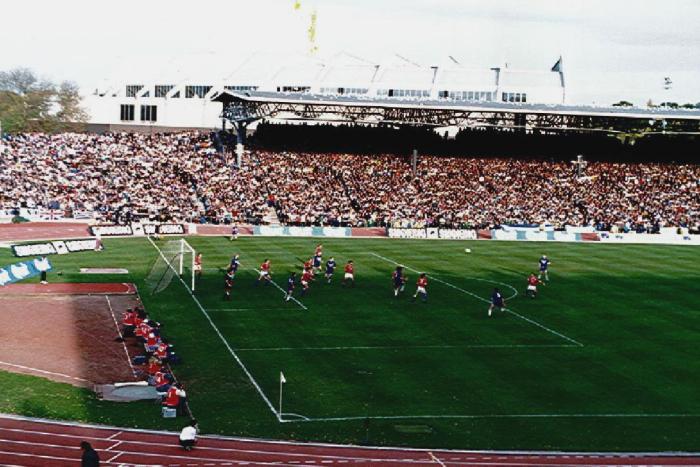
For the 1995/96 season, construction at our new stadium, Bob Jane Stadium, was completed and we played our first home game on Round 9 on 26 November 1995 against West Adelaide where we lost 3-2. Danny Allsop scored along with Paul Trimboli. The launch of Bob Jane Stadium was a big event and we packed the stadium. The stadium was a major feature for the National Soccer League and the envy of all. This was a pivotal time for the Club which continued to prosper with record membership, crowds and sponsorship coinciding with the opening of Bob Jane Stadium.
As we approached the end of the 1995/96 season, we saw the end of the Frank Arok era with three (3) games to spare as it became evident that the Club would miss out on the finals for the first time since 1989 and Assistant Coach, Ange Postecoglou was put in charge as interim coach for the last three (3) games winning all three (3) at which point the search for our new coach commenced immediately and I will touch upon in a later blog as to this journey and the emergence of Ange Postecoglou and the successes of that time in more detail. Ange’s path to where he is today as Socceroos coach is a fascinating tale of passion, commitment, ambition and hard work – I will share my insights into this wonderful story of Ange Postecoglou and his journey from retiring National Soccer League player through to back-to-back championship winning Head Coach of South Melbourne Soccer Club.
I do vividly recall prior to Frank’s removal as coach, after a game where we had lost to Marconi 3-0 at Marconi and a spray Ange gave the players on the long bus trip to the airport which has left its mark on me even today. To be fair the players were misbehaving on the bus and carrying on somewhat without showing much hurt after such a drubbing at the hands of a rival and Ange felt it was time he reminded them in the strongest possible way about the badge that they represented and “how they had disgraced it that day”. Little did I know at the time that the Socceroos Coach was born that day. A word was not spoken amongst the travelling party for the remainder of the trip and even remember the players shuffling boarding passes so no one would sit next to Ange on the plane. I don’t think Frank said a word for the entire trip slumped in a chair on the bus reflecting on the performance. I also remember telling my President the following day of Ange’s exceptional display of leadership and how he would one day be our Head Coach.
After a whirlwind meeting at the Board meeting the following week, I recall having to call in Frank Arok the following day and arrange a meeting to advise him that the Board had unanimously decided to terminate his coaching tenure with the Club effective immediately. There was immense and mounting pressure from sponsors, fans and members who would not put up with this mediocrity and the Board had to act swiftly. Our club stakeholders demanded and expected success.
I couldn’t believe that I had just sacked the longest serving ex-Socceroos Coach and a man I admired and learned so much from. He was a friend and still remains a friend to this day. Many will tell you that Frank’s impact at the Club was effective and long lasting. He began a process where he had set the foundations for our successes in the subsequent next few years. Unfortunately the Board and Fans had run out of patience and as a Club we succumbed to the the need for immediate success. Clubs like South Melbourne and its strong fan base, demanded success.
The emergence of Ange
Later that morning, I visited Ange Postecoglou at the bank on Clarendon Street, South Melbourne where he worked as a teller to firstly inform him of the decision to terminate Frank’s contract immediately and secondly that the Board had decided that he would take the reigns at interim coach for the remaining three games of the season. Ange is not one to show too much emotion and in my experience with him, holds his cards close to his chest. However, I saw the look in Ange’s eyes that day as I broke the news to him and I could see a person who understood the opportunity presented before him. He sprung to action calling a meeting of the team the following day where he unveiled a carefully thought out plan for the remaining games. He was determined to prove that he should be given the coaching job permanently. Ange had enormous respect in the dressing rooms and the results showed this with three wins from three starts as we finished that season.
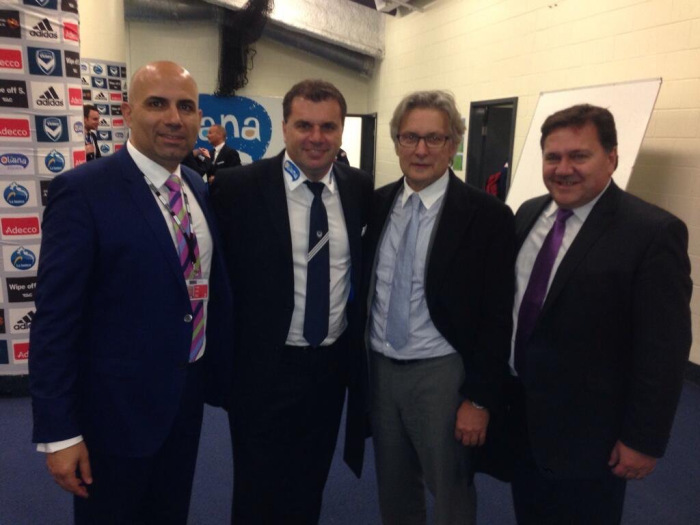
On reflection
Since taking on the role as General Manager a few years earlier, the Club was achieving record membership, sponsorship, match day attendances and had built a formidable team which was in desperate need of a coach to help reach their potential. I had developed skills by learning them on the job and in practise.
South Melbourne was widely acclaimed as the leading and most professional club in the National Soccer League. So many worked tirelessly to reach this stage and as a young administrator learning the caper, I rarely was home before 8pm every night. By 1997 we had an office which consisted of a General Manager, Sales & Marketing Manager, Office Manager, full-time Social Club Manager and a team of Chefs and casual staff. It was only recently when some one tweeted a match day programme, “In Blue and White”, from the 1998/99 season where we had announced a major sponsor worth $1M over two (2) years which would have rivalled most of the AFL clubs at the time. Having a look at the list of sponsors we had fantastic corporate support.
My entry into the world of sports administration was a whirl wind experience and by the end of the 1998/99 season where we had won Back to Back Championships under young Coach, Ange Postecoglou, I was beginning to contemplate where this journey would take me next. I had completed six (6) wonderful years but I knew that if I would master this new career path, I needed to expand upon my experience maybe outside of football.
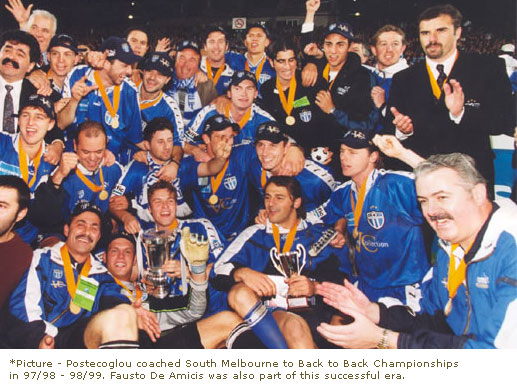
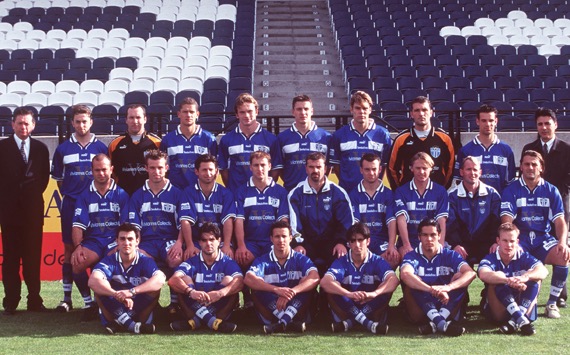
It was in early 1999 that I had meet President, Ian Dicker and CEO, Michael Brown from Hawthorn Football Club via our mutual sponsors Puma. My next opportunity was about to take shape, which I will also elaborate in a later blog. As the Club was preparing for the inaugural FIFA World Club Championships scheduled for January 2000 to play against the likes of Vasco De Gama and Manchester United, I was beginning a new journey with a rival football code, the AFL, with the Hawthorn Football Club. The next 15 years sees me with the AFL for 8 years (3 with Hawthorn and 5 with North Melbourne), 7 years with Etihad Stadium and 18 months with Swimming Australia before accepting the CEO role at Perth Glory and relocating the family to Perth in August , 2015.
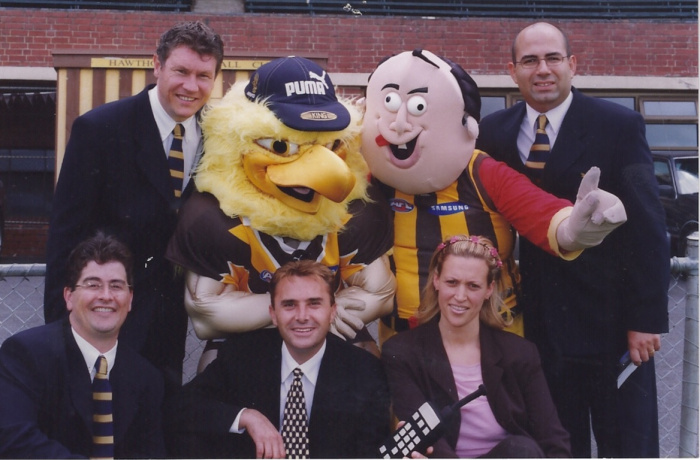
During my six years at South Melbourne, I can now say, I was thrown in the deep end and in front of buses, however, I recall these days with fondness and have taken so many learnings from this experience and remain friends with so many wonderful people from that era. It was a ‘sink or swim’ environment and I am proud to say I survived.
South Melbourne still exists today and participates in the NPL Victoria based at Lakeside Stadium which has gone through another major transformation and most likely the best facility in the National Premier League.
I am proud to remain a life member of the Club today and I am grateful for the opportunity given to me back in 1993 to take on the reigns as General Manager / CEO which has paved my career to where it is today. So many fond memories and close bonds that I will never forget.
Fifteen years later, in my current role as CEO of Perth Glory Football Club, participating in the Hyundai A-League, I draw upon my experiences and learnings from South Melbourne often and I have been overwhelmed by the support I have received since returning to the game I love, all because I was once involved with South Melbourne which has helped get instant acceptance and respect.
Peter Filopoulos